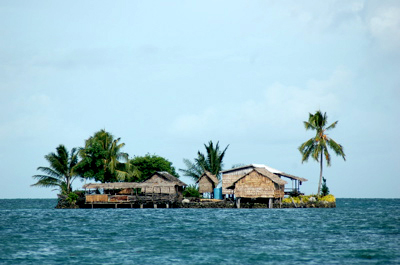|
Pā (Māori)
The word pā (; often spelled pa in English) can refer to any Māori village or defensive settlement, but often refers to hillforts – fortified settlements with palisades and defensive terraces – and also to fortified villages. Pā sites occur mainly in the North Island of New Zealand, north of Lake Taupō. Over 5,000 sites have been located, photographed and examined, although few have been subject to detailed analysis. Variations similar to pā occur throughout central Polynesia, in the islands of Fiji, Tonga and the Marquesas Islands. In Māori culture, a great pā represented the mana (prestige or power) and strategic ability of an iwi (tribe or tribal confederacy), as personified by a rangatira (chieftain). Māori built pā in various defensible locations around the territory (rohe) of an iwi to protect fertile plantation-sites and food supplies. Description Almost all pā were constructed on prominent raised ground, especially on volcanic hills. The natural slo ... [...More Info...] [...Related Items...] OR: [Wikipedia] [Google] [Baidu] |
Prehistoric Storage Pits
Storage pits are underground cists that were used historically to protect the seeds for the following year's crops, and to stop surplus food from being eaten by insects and rodents. These underground pits were sometimes lined and covered, for example with slabs of stone and bark and tightly sealed with adobe.''Man in the San Juan Valley.'' Aztec Ruins National Monument, National Park Service. January 13, 2001. Retrieved 10-18-2011. Examples Sannai-Maruyama Site in Aomori, |
Ariki
An ariki (New Zealand, Cook Islands), ꞌariki ( Easter Island), aliki (Tokelau, Tuvalu), ali‘i (Samoa, Hawai‘i), ari'i (Society Islands, Tahiti), Rotuma) aiki or hakaiki ( Marquesas Islands), akariki (Gambier Islands) or ‘eiki (Tonga) is or was a member of a hereditary chiefly or noble rank in Polynesia. New Zealand Political leadership or governance in Māori society has traditionally come from two overlapping groups of people – the and the . The are the "persons of the highest rank and seniority". As the "high-ranking first-born children of first-born children", inherit their positions from their forebears. In particular, their "supreme rank omesfrom the conjunction of a number of senior descent lines from founding ancestors, and ultimately from the gods". Their combines hereditary, personal and theocratic elements. In Māori culture were men or women. A modern example of a woman in this leadership role is Te Atairangikaahu () the paramount head or Māori Quee ... [...More Info...] [...Related Items...] OR: [Wikipedia] [Google] [Baidu] |
Whare
A wharenui (; literally "large house") is a communal house of the Māori people of New Zealand, generally situated as the focal point of a ''marae''. Wharenui are usually called meeting houses in New Zealand English, or simply called '' whare'' (a more generic term simply referring to any house or building). Also called a ''whare rūnanga'' ("meeting house") or ''whare whakairo'' (literally "carved house"), the present style of wharenui originated in the early to middle nineteenth century. The houses are often carved inside and out with stylized images of the iwi's (or tribe's) ancestors, with the style used for the carvings varying from tribe to tribe. Modern meeting houses are built to regular building standards. Photographs of recent ancestors may be used as well as carvings. The houses always have names, sometimes the name of a famous ancestor or sometimes a figure from Māori mythology. Some meeting houses are built at places that are not the location of a tribe, but where ... [...More Info...] [...Related Items...] OR: [Wikipedia] [Google] [Baidu] |
Adam Matthew Digital
Adam Matthew Digital is an academic publisher based in the United Kingdom and the United States. It has been an independent subsidiary of SAGE Publications since 2012. The company specializes in online primary source databases and curated collections for the humanities and social sciences. Its corporate offices are in Marlborough, Wiltshire. History Adam Matthew Publications was founded in 1990 by David Tyler and William Pidduck. The company focused on publishing microfilm collections with a back list of over 600 titles until publishing their first ‘digital’ collections in the late 1990s on CD-ROM, and releasing its first truly online resources in the early 2000s. By the mid-2000s, the company directors – now including Khal Rudin – founded Adam Matthew Digital to focus solely on the development and production of digital collections, and began trading as a separate entity from 1 January 2007. On 5 October 2012, the company was acquired by SAGE Publications. Collection ... [...More Info...] [...Related Items...] OR: [Wikipedia] [Google] [Baidu] |
Pahu
The term "pahu" is a general word for drum in Hawaiian culture however, there are a variety of them. To fully understand the "pahu" as it pertains to dance, it's important to consider the following explanation. Since the mid-1800s, the term "hula" has been widely used to encompass all aspects of Hawaiian dance. Historically, however, ancient Hawaiians used two distinct terms to describe dance movements. "Hula" specifically referred to formalized dance performed by humans in non-sacred contexts. In contrast, "haʻa" was the term used for formalized movements performed in sacred or mourning contexts. "Haʻa" was also performed by deities and non-human entities, including personified natural forces like flowers, birds, trees, winds, or lava, as well as puppets (kiʻi). The confusion between "hula" and "haʻa", particularly regarding the sacred nature of the dance, is largely attributed to Emerson, who did not differentiate between the two in early written accounts. Example: In a ... [...More Info...] [...Related Items...] OR: [Wikipedia] [Google] [Baidu] |
Artificial Island
An artificial island or man-made island is an island that has been Construction, constructed by humans rather than formed through natural processes. Other definitions may suggest that artificial islands are lands with the characteristics of human intervention in their formation process, while others argue that artificial islands are created by expanding existing islets, constructing on existing reefs, or amalgamating several islets together. Although constructing artificial islands is not a modern phenomenon, there is no definite legal definition of it. Artificial islands may vary in size from small islets reclaimed solely to support a single pillar of a building or structure to those that support entire communities and cities. Archaeology, Archaeologists argue that such islands were created as far back as the Neolithic, Neolithic era. Early artificial islands included floating island, floating structures in still waters or wooden or megalithic structures erected in Ocean bank, s ... [...More Info...] [...Related Items...] OR: [Wikipedia] [Google] [Baidu] |
Volcano
A volcano is commonly defined as a vent or fissure in the crust of a planetary-mass object, such as Earth, that allows hot lava, volcanic ash, and gases to escape from a magma chamber below the surface. On Earth, volcanoes are most often found where tectonic plates are diverging or converging, and because most of Earth's plate boundaries are underwater, most volcanoes are found underwater. For example, a mid-ocean ridge, such as the Mid-Atlantic Ridge, has volcanoes caused by divergent tectonic plates whereas the Pacific Ring of Fire has volcanoes caused by convergent tectonic plates. Volcanoes resulting from divergent tectonic activity are usually non-explosive whereas those resulting from convergent tectonic activity cause violent eruptions."Mid-ocean ridge tectonics, volcanism and geomorphology." Geology 26, no. 455 (2001): 458. https://macdonald.faculty.geol.ucsb.edu/papers/Macdonald%20Mid-Ocean%20Ridge%20Tectonics.pdf Volcanoes can also form where there is str ... [...More Info...] [...Related Items...] OR: [Wikipedia] [Google] [Baidu] |
Storage Pit (archaeology)
Storage pits are underground cists that were used historically to protect the seeds for the following year's crops, and to stop surplus food from being eaten by insects and rodents. These underground pits were sometimes lined and covered, for example with slabs of stone and bark and tightly sealed with adobe.''Man in the San Juan Valley.'' Aztec Ruins National Monument, National Park Service. January 13, 2001. Retrieved 10-18-2011. Examples Sannai-Maruyama Site in Aomori, |
United Kingdom Of Great Britain And Ireland
The United Kingdom of Great Britain and Ireland was the union of the Kingdom of Great Britain and the Kingdom of Ireland into one sovereign state, established by the Acts of Union 1800, Acts of Union in 1801. It continued in this form until 1927, when it evolved into the United Kingdom, United Kingdom of Great Britain and Northern Ireland, after the Irish Free State gained a degree of independence in 1922. It was commonly known as Great Britain, Britain or England. Economic history of the United Kingdom, Rapid industrialisation that began in the decades prior to the state's formation continued up until the mid-19th century. The Great Famine (Ireland), Great Irish Famine, exacerbated by government inaction in the mid-19th century, led to Societal collapse, demographic collapse in much of Ireland and increased calls for Land Acts (Ireland), Irish land reform. The 19th century was an era of Industrial Revolution, and growth of trade and finance, in which Britain largely dominate ... [...More Info...] [...Related Items...] OR: [Wikipedia] [Google] [Baidu] |
Defensive Wall
A defensive wall is a fortification usually used to protect a city, town or other settlement from potential aggressors. The walls can range from simple palisades or earthworks to extensive military fortifications such as curtain walls with towers, bastions and gates for access to the city. From ancient to modern times, they were used to enclose settlements. Generally, these are referred to as city walls or town walls, although there were also walls, such as the Great Wall of China, Walls of Benin, Hadrian's Wall, Anastasian Wall, and the Atlantic Wall, which extended far beyond the borders of a city and were used to enclose regions or mark territorial boundaries. In mountainous terrain, defensive walls such as '' letzis'' were used in combination with castles to seal valleys from potential attack. Beyond their defensive utility, many walls also had important symbolic functions representing the status and independence of the communities they embraced. Existing ancient walls ... [...More Info...] [...Related Items...] OR: [Wikipedia] [Google] [Baidu] |
Water Well
A well is an excavation or structure created on the earth by digging, driving, or drilling to access liquid resources, usually water. The oldest and most common kind of well is a water well, to access groundwater in underground aquifers. The well water is drawn up by a pump, or using containers, such as buckets that are raised mechanically or by hand. Water can also be injected back into the aquifer through the well. Wells were first constructed at least eight thousand years ago and historically vary in construction from a sediment of a dry watercourse to the qanats of Iran, and the stepwells and sakiehs of India. Placing a lining in the well shaft helps create stability, and linings of wood or wickerwork date back at least as far as the Iron Age. Wells have traditionally been sunk by hand digging, as is still the case in rural areas of the developing world. These wells are inexpensive and low-tech as they use mostly manual labour, and the structure can be lined with b ... [...More Info...] [...Related Items...] OR: [Wikipedia] [Google] [Baidu] |




